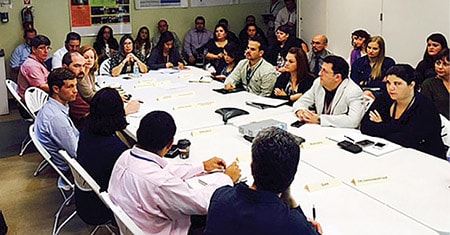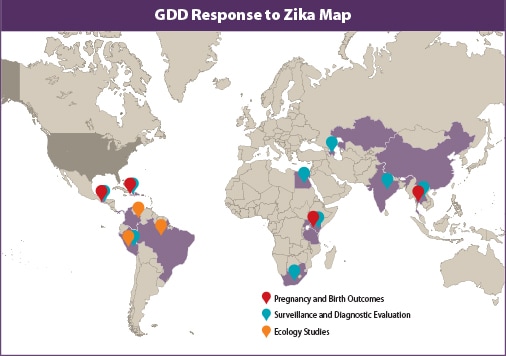Leveraging Resources and Program Expertise to Respond to Zika
March 24, 2017

Morning Incident Management update meeting at Puerto Rico Department of Health Public Health Emergency Program building where the Emergency Operations Center was located.
Zika virus remains a serious health threat that is likely to continue until a safe and effective vaccine becomes available and is widely implemented. Threats from mosquito-borne infection will continue until better vector control interventions are developed. The severe consequences of Zika virus infection require a long-term approach with dedicated resources (MMWR Weekly / January 6, 2017 / 65(52);1482-1488).
DGHP branches—Epidemiology, Informatics, Surveillance, and Laboratory Branch (EISLB), Emergency Response and Recovery Branch (ERRB), and Workforce Institute and Development Branch (WIDB)—received Zika funds from Congress to build capacity, enhance response activities, and develop and conduct research to support the Zika response efforts and address outstanding questions about Zika virus infections.
Global Disease Detection’s Response to Zika

EISLB works with ministries of health in multiple countries to develop and enhance public health capacity to rapidly detect, accurately identify, and promptly contain emerging diseases. Zika research activities are ongoing at nine of the 10 Global Disease Detection (GDD) Regional Centers in Bangladesh, China, Egypt, Georgia, Guatemala, India, Kenya, South Africa, and Thailand and at the CDC-Haiti office. EISLB is also partnering with the Naval Medical Research Unit-Six in Peru and CDC colleagues from the Division of Vector Borne Disease to conduct ecology studies in Peru, Colombia, and Brazil. EISLB’s activities focus on implementing needed surveillance activities and research studies to determine the incidence of Zika virus infection, understand where Zika is found and how it spreads, study pregnancy and birth outcomes, understand the relationships between humans, animals, and the environment in relation to Zika, and evaluate new ways to diagnose Zika virus infection. EISLB can conduct these activities because of its ongoing global work with ministries of health, ministries of agriculture, universities, U.S. government agencies, and other research partners.
Field Epidemiology Training Program in Zika-Affected Countries
WIDB’s Field Epidemiology Training Program (FETP) team trains workforce on the ground to help countries build sustainable capacity for detecting and responding to health threats. The program develops in-country expertise so that disease outbreaks can be detected locally and prevented from spreading. FETP and collaborating partners, RedSur, TEPHINET, CONSEJO DE Ministros de salud de centro America (COMISCA), Council of Ministries of health of Central America, and Universidad del Valle de Guatemala, work toward enhancing the epidemiological skills among health workers in Latin America and the Caribbean to detect and respond to Zika infection.
The Zika-affected countries included in the FETP work include those in Central America and the Caribbean, and Brazil, Colombia, Paraguay, Peru, Haiti, Mexico, Uruguay, Guyana, Surinam, and the Dominican Republic.
Global Response Preparedness Team’s Zika Response in Central America Region and the Caribbean Community
To support efforts in the preparedness and response to the Zika Virus, ERRB’s Global Response Preparedness Team (GRPT) performed needs assessments for emergency preparedness and response capacities, and has provided emergency response assistance to five countries of the Central America Region and the Caribbean Community.
Since June 2016, basic needs assessments were completed in Guatemala, the Dominican Republic, Panama, and Colombia. The Barbados assessment is scheduled for completion in late January 2017. The assessments and assistance provided by GRPT and the Office of Public Health Preparedness and Response’s Global Emergency Management Capacity Development Branch will enhance participating countries’ abilities to respond to the Zika virus outbreak.
Supported by the Zika funds, DGHP has helped build capacities and conducted studies to address outstanding questions about Zika virus infections. These activities will build the detection and response capacity of public health institutes in numerous countries, increase the likelihood of controlling public health problems like Zika infections at their source, and enhance global health security.